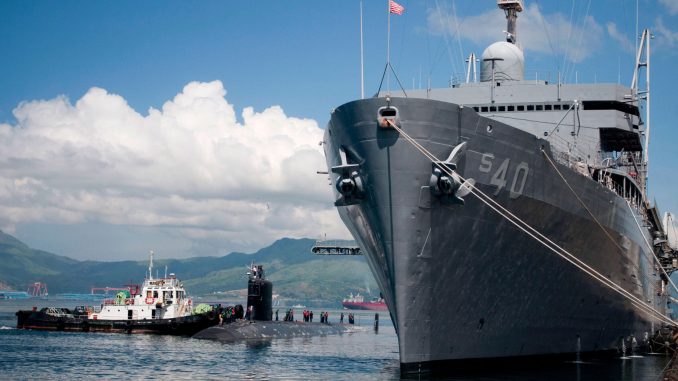
As China continues to flagrantly and aggressively assert its influence in the Pacific, the need to maintain a strong naval presence is paramount for deterring a potential conflict—or for winning one, if necessary.
Key to that are U.S. Navy submarines. To support those submarines while deployed, the Navy recently released an updated solicitation on a new class of submarine tenders under the AS(X) program. (A tender is a ship that provides maintenance and support to other ships.)
Logistics ships may not be as flashy as warships, but are an absolutely critical component to a fleet that operates on the other side of the Pacific.
The AS(X) class will be a series of ships set to replace the aging Emory S. Land-class of tenders commissioned more than 40 years ago. The Navy’s Naval Sea Systems Command has identified the AS(X) as a key future shipbuilding program, and it will play an essential part in sustaining deployed Virginia-class attack submarines.
For fiscal 2024, the Navy has requested $1.7 billion for AS(X), a significant increase over the previous year, and that will accelerate its development. The Navy has chosen to prioritize AS(X) even as it is forced to make tough budget decisions elsewhere.
According to the solicitation announcement, the new AS(X) ships will “conduct steady state and wartime sustained, forward-based tending, resupply, and I-level repair operations on deployed submarines while at anchor or moored at a pier. In steady state, the AS(X) provides pier-side support in a forward deployed submarine homeport, providing sustained repair, supply, weapons handling/rearming, and tending operations for home ported or visiting submarines and ships, and fly-away emergent voyage repair services for other deployed submarines and ships.”
“I-level repair operations” are maintenance or repair operations too complex or labor-intensive for the crew to do itself and that must be performed by a ship’s tender like the AS(X).
China’s development of a new nuclear submarine, the Type 096, could prove to be a challenging asset to counter. According to one of the U.S. Naval War College’s researchers, Christopher Carlson, “The Type 096s are going to be a nightmare. They are going to be very, very hard to detect.”
Furthermore, the modernization and expansion of the Chinese navy not only has increased the lethality of China’s naval prowess, but also has surpassed the U.S. Navy in number of battle-force ships. That only further solidifies the need for the AS(X) program to keep every submarine we have operational while forward-deployed.
As the Navy plans to decommission the remaining two Emory S. Land-class tenders by 2027, it is important to have new AS(X) ships in construction and being delivered beginning at least by 2026 (as recommended by Heritage Foundation senior fellow Brent Sadler in his book “U.S. Naval Power in the 21st Century”).
Apart from playing a crucial role in the Navy’s Pacific strategy, the AS(X) program offers a unique opportunity for our allies in the region. In March of this year, Australia, the United States, and the United Kingdom announced the AUKUS agreement, which would provide the Royal Australian Navy with at least eight nuclear-powered attack submarines, at least three of which will be American Virginia-class submarines.
This historic deal will also see the development of a joint British-Australian AUKUS-class submarine and a multibillion-dollar pledge by all three nations to develop a trilateral submarine base in the region.
AS(X) tenders can be used today to train Australian sailors as they prepare to commission their own nuclear submarines. This exchange of expertise is crucial to Washington’s Pacific strategy, as Australia is critical to supporting U.S. operations in the Indo-Pacific and maintaining the increasingly fragile balance of power. Done well, this would be a win-win for both nations.
Moreover, in an era of budget constraints and the need for efficient resource allocation, the older Emory S. Land-class vessels can still be put toward good use in the Pacific. The two existing tenders, the USS Emory S. Land (AS-39) and the USS Frank Cable (AS-40) are still in service with the Navy in Guam.
The other remaining ship of the class, the USS McKee (AS-41), currently sits idle in port in Norfolk, Virginia. Rather than let it sit in a port, the Navy would do well to deploy it to fill a training and deployed maintenance role in Australia alongside the remaining two tenders as the Navy awaits the AS(X)s.
The AS(X)-class submarine tender program is not just a future part of the U.S. Navy; it is a linchpin in the security and stability of the Pacific region. These tenders are the unsung heroes of the Navy’s strategy in the Indo-Pacific, safeguarding American interests and regional stability.
It’s imperative that we recognize and harness their full potential, ensuring the Pacific remains a region of security and stability in an increasingly tumultuous world.
Have an opinion about this article? To sound off, please email letters@DailySignal.com and we’ll consider publishing your edited remarks in our regular “We Hear You” feature. Remember to include the url or headline of the article plus your name and town and/or state.

Be the first to comment